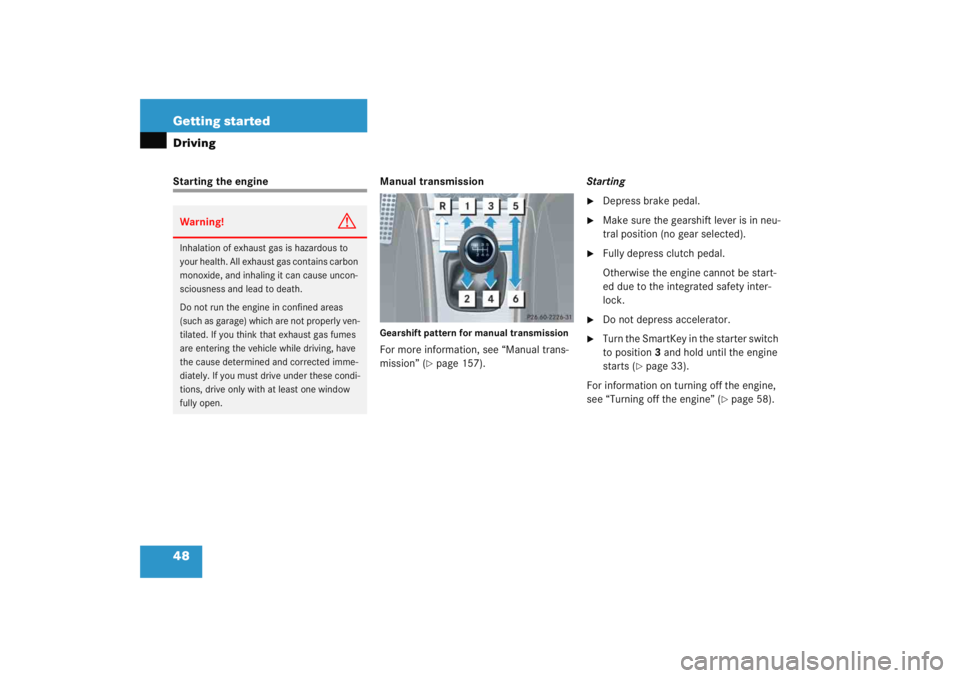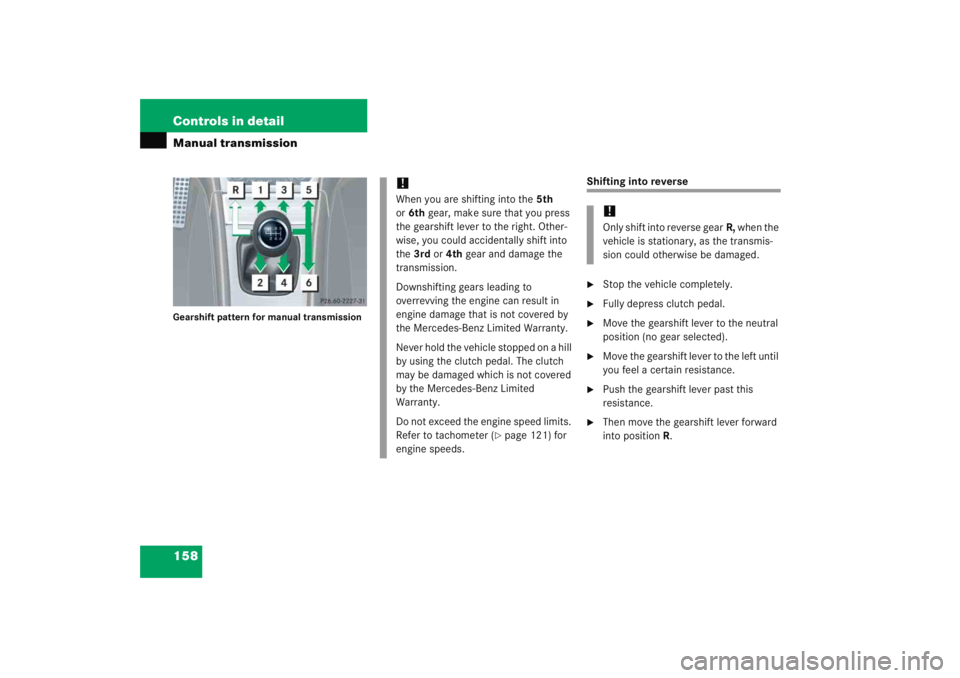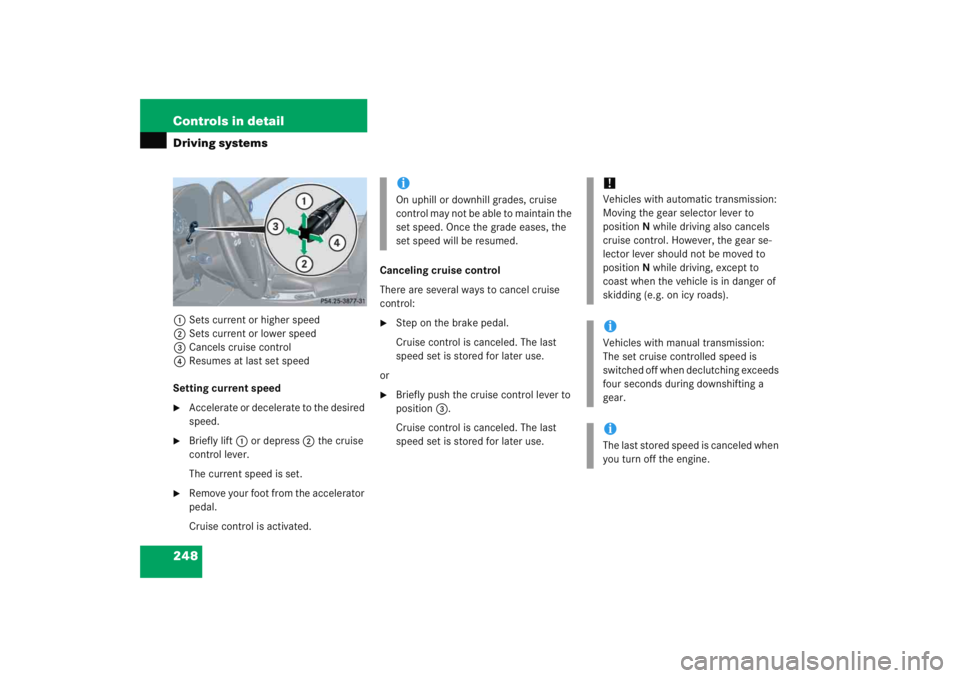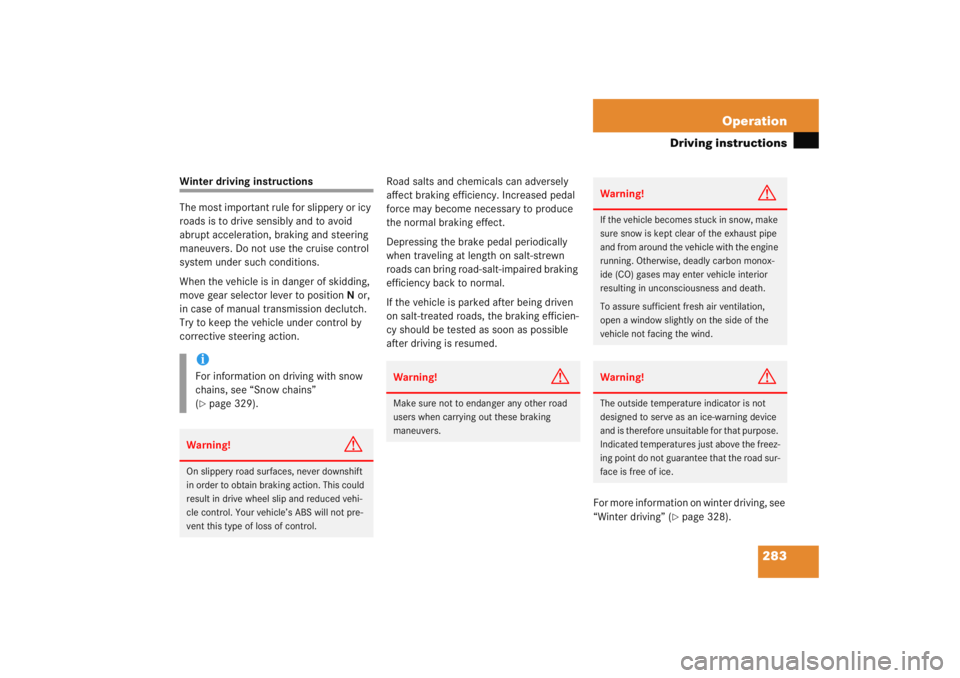Page 49 of 474

48 Getting startedDrivingStarting the engineManual transmission
Gearshift pattern for manual transmissionFor more information, see “Manual trans-
mission” (
�page 157).Starting
�
Depress brake pedal.
�
Make sure the gearshift lever is in neu-
tral position (no gear selected).
�
Fully depress clutch pedal.
Otherwise the engine cannot be start-
ed due to the integrated safety inter-
lock.
�
Do not depress accelerator.
�
Turn the SmartKey in the starter switch
to position
3 and hold until the engine
starts (
�page 33).
For information on turning off the engine,
see “Turning off the engine” (
�page 58).
Warning!
G
Inhalation of exhaust gas is hazardous to
your health. All exhaust gas contains carbon
monoxide, and inhaling it can cause uncon-
sciousness and lead to death.
Do not run the engine in confined areas
(such as garage) which are not properly ven-
tilated. If you think that exhaust gas fumes
are entering the vehicle while driving, have
the cause determined and corrected imme-
diately. If you must drive under these condi-
tions, drive only with at least one window
fully open.
Page 159 of 474

158 Controls in detailManual transmissionGearshift pattern for manual transmission
Shifting into reverse�
Stop the vehicle completely.
�
Fully depress clutch pedal.
�
Move the gearshift lever to the neutral
position (no gear selected).
�
Move the gearshift lever to the left until
you feel a certain resistance.
�
Push the gearshift lever past this
resistance.
�
Then move the gearshift lever forward
into position R.
!When you are shifting into the 5th
or 6th gear, make sure that you press
the gearshift lever to the right. Other-
wise, you could accidentally shift into
the 3rd or4th gear and damage the
transmission.
Downshifting gears leading to
overrevving the engine can result in
engine damage that is not covered by
the Mercedes-Benz Limited Warranty.
Never hold the vehicle stopped on a hill
by using the clutch pedal. The clutch
may be damaged which is not covered
by the Mercedes-Benz Limited
Warranty.
Do not exceed the engine speed limits.
Refer to tachometer (
�page 121) for
engine speeds.
!Only shift into reverse gear R, when the
vehicle is stationary, as the transmis-
sion could otherwise be damaged.
Page 249 of 474

248 Controls in detailDriving systems1Sets current or higher speed
2 Sets current or lower speed
3 Cancels cruise control
4 Resumes at last set speed
Setting current speed�
Accelerate or decelerate to the desired
speed.
�
Briefly lift 1 or depress 2 the cruise
control lever.
The current speed is set.
�
Remove your foot from the accelerator
pedal.
Cruise control is activated. Canceling cruise control
There are several ways to cancel cruise
control:
�
Step on the brake pedal.
Cruise control is canceled. The last
speed set is stored for later use.
or
�
Briefly push the cruise control lever to
position 3.
Cruise control is canceled. The last
speed set is stored for later use.iOn uphill or downhill grades, cruise
control may not be able to maintain the
set speed. Once the grade eases, the
set speed will be resumed.
!Vehicles with automatic transmission:
Moving the gear selector lever to
position N while driving also cancels
cruise control. However, the gear se-
lector lever should not be moved to
position N while driving, except to
coast when the vehicle is in danger of
skidding (e.g. on icy roads).iVehicles with manual transmission:
The set cruise controlled speed is
switched off when declutching exceeds
four seconds during downshifting a
gear.iThe last stored speed is canceled when
you turn off the engine.
Page 284 of 474

283
Operation
Driving instructions
Winter driving instructions
The most important rule for slippery or icy
roads is to drive sensibly and to avoid
abrupt acceleration, braking and steering
maneuvers. Do not use the cruise control
system under such conditions.
When the vehicle is in danger of skidding,
move gear selector lever to position
N or,
in case of manual transmission declutch.
Try to keep the vehicle under control by
corrective steering action. Road salts and chemicals can adversely
affect braking efficiency. Increased pedal
force may become necessary to produce
the normal braking effect.
Depressing the brake pedal periodically
when traveling at length on salt-strewn
roads can bring road-salt-impaired braking
efficiency back to normal.
If the vehicle is parked after being driven
on salt-treated roads, the braking efficien-
cy should be tested as soon as possible
after driving is resumed.
For more information on winter driving, see
“Winter driving” (
�page 328).
iFor information on driving with snow
chains, see “Snow chains”
(�page 329).
Warning!
G
On slippery road surfaces, never downshift
in order to obtain braking action. This could
result in drive wheel slip and reduced vehi-
cle control. Your vehicle’s ABS will not pre-
vent this type of loss of control.
Warning!
G
Make sure not to endanger any other road
users when carrying out these braking
maneuvers.
Warning!
G
If the vehicle becomes stuck in snow, make
sure snow is kept clear of the exhaust pipe
and from around the vehicle with the engine
running. Otherwise, deadly carbon monox-
ide (CO) gases may enter vehicle interior
resulting in unconsciousness and death.
To assure sufficient fresh air ventilation,
open a window slightly on the side of the
vehicle not facing the wind.Warning!
G
The outside temperature indicator is not
designed to serve as an ice-warning device
and is therefore unsuitable for that purpose.
Indicated temperatures just above the freez-
ing point do not guarantee that the road sur-
face is free of ice.
Page 441 of 474

440 Technical termsMultifunction displayDisplay field in the instrument cluster
used to present information provided
by the control system.
Multifunction steering wheel Steering wheel with buttons for operat-
ing the control system.
Normal occupant weight (
�page 324)
OCS (Occupant C
lassification S
ystem)
The system automatically turns the
front passenger front air bag on or off
based on the classified occupant size
category determined by weight sensor
readings from the seat.
Overspeed range Engine speeds within the red marking
of the tachometer dial. Avoid this en-
gine speed range, as it may result in se-
rious engine damage that is not
covered by the Mercedes-Benz Limited
Warranty. Poly-V-belt drive
Drives engine-components (alternator,
AC compressor, etc.) from the engine.
Power train Collective term designating all compo-
nents used to generate and transmit
motive power to the drive axles, includ-
ing
�
engine
�
clutch/torque converter
�
transmission
�
transfer case
�
drive shaft
�
differential
�
axle shafts/axles
Production options weight (
�page 324)
Program mode selector switch Used to switch the automatic transmis-
sion between standard operation S and
winter operation C. PSI
(P
ounds per s
quare i
nch)
(
�page 325)
Recommended tire inflation pressure (�page 325)
Restraint systems Seat belts, child restraints, lower an-
chors and tethers for children (LATCH).
As independent systems, their protec-
tive functions complement one
another.
Rim (�page 325)
RON (Research O
ctane N
umber)
The Research Octane Number for gaso-
line as determined by a standardized
method. It is an indication of a gaso-
line's ability to resist undesired detona-
tion (knocking). The average of both
the ->MON (Motor Octane Number)
and RON (Research Octane Number) is
posted at the pump, also known as AN-
TI-KNOCK INDEX.